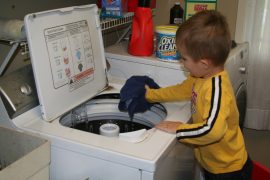To what degree of grief or cost do you find in cleaning your clothes? Water or drycleaning a solvent, an evaluation of what you are cleaning in and how you do it as well as how dirty are the clothes you clean, will mandate your approach and degree of success. After talking to my friend Jeff Schwarz (aka: Stain Wizard) of A.L. Wilson Chemical Company recently, we talked about something I said in a class many years ago in San Francisco. The subject was cleaning and stain removal. Nothing has changed since then, except sometimes people aren’t accepting the facts. And the facts are that decisions should be made before choosing how to clean clothes.
First and foremost is to ask yourself, “How dirty are the clothes that come into my stores?” Prespotting will depend on three things:
1) How dirty are the clothes in general?
2) What part of town do they come from?
3) What type of solvent do I use?
4) Do I wetclean or dryclean?
The deciding factor is greatly related to the solvent you use and how you use it. I have watched drycleaners all my life swear on this solvent and that solvent. Especially since 1992 when the Clean Air Act came about, which forced the industry to look for benign solvents. That would be the benign cleaning ability and the ultimate benign air pollutant. There has not been, nor has there ever been, a perfect solution to those problems. One problem accentuates the other. We will have to accept the fact that we are cleaning in weak solvents these days.
Cheap Products Deliver Cheap Results
The old practice of heating solvents (perc) was used many; many years ago to hand clean difficult items. Back then, it would remove stains real well without disturbing the dye. Some of today’s fabric will bleed if you stare at it wrong. A good cleaning detergent in drycleaning solvent and a good detergent in water that is designed to work in your unit and provide ultimate cleaning abilities is a must. Decent drycleaning detergents are very necessary to help protect the machine, solvent, clothes and give ultimate performance is also a necessity. Cheap products deliver cheap results.
I wish I had a nickel for every time I saw a new drycleaner to the industry get excited about using the newest solvent on the market. They have no idea what a good solvent is or anything else for that matter. They won’t attend school or read a book/periodical from the industry so they learn by ruining things and quality will be illusive to them. The word will be touted and advertised but it will have no meaning. How in perdition can a person declare a new machine and solvent great before they learn about it? Ignorance can be avoided by seeking help from someone. Our beloved industry has great schools and trainers that can be an asset to your business.
No Secret Formula’s
As for prespotting, on goes the debate or battle of when, if or how much to do. I have worked with people who insist that every garment must be pre-spotted. That is not necessary but if it makes you feel better, continue doing so. You will soon learn that all stains must be treated differently and you need a multitude of chemical stain removers to do it correctly. No secret formulas. I have seen those over the years too. Often, they are a cocktail of things that should not be mixed together, and it makes a veteran feel good to think he is smarter than the chemical companies. Again, I say, there are no secret formulas.
I had a dear friend ask me not long ago, why she should pay for drycleaning when they did not get out all she stains. I tried to explain to her that we have to pay for the work and time of about 4 employees to process it. The insurance we pay to track her garments while left in our plant and the chance of fire or theft. All of these issues feed into our reasoning for paying for the drycleaning. You hear that in laundry also. A $2.50 laundry shirt full of stains and they want their money back. Go figure! One thing is certain in this all too familiar scenario; they got handled, protected, cleaned and pressed and I have to pay that expense, so no free drycleaning or laundry just because the stains would not come out. The new operators are not savvy to our industry struggle with this problem for the first year until they realize it is a faulty attempt to please the customers and drain your profit margins.
So…the degree of dirt and stains of the clothes you receive to process is directly affected in your cost and turnaround time. Don’t you hate to slam out filthy clothes as a special for that day? What a mess that can be. Frankly, in all my years in this industry, no one has ever convinced me that “fast service is good service” when cleaning clothes. You simply need more time to process garments correctly. Quality always has and always will be directly affected by price, speed and poor cleaning and finishing. Your perception of quality may not agree with the industry standards. There are many that I have found did not agree with me. So be it.
I hope this article gave you some food for thought. Some progress is good but a great deal of so-called progress is lost to the wind. Progress is never a bargain. See ya next month.
I’m headin’ to the wagon now, these boots are killin’ me!

